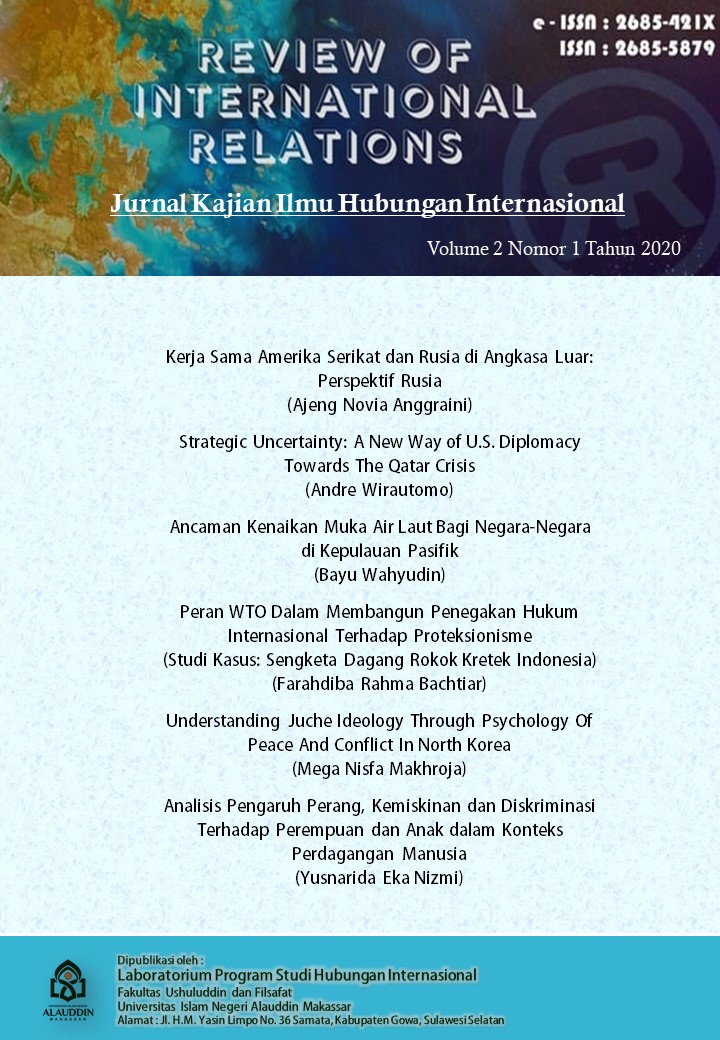KERJA SAMA AMERIKA SERIKAT DAN RUSIA DI ANGKASA LUAR: PERSPEKTIF RUSIA
Abstract
This paper analyzes the U.S.-Russia cooperation of space security as two superpowers in the form of the ISS program. Most of the previous articles on this topic only explained the background of the ISS project and the process of Russia joining this project. U.S and Rusia have a “high intention” relationship during the Cold War. Even today the United States and Russia are still at odds with many things. This article uses theory of international cooperation that can explain the reasons behind Russia joint the ISS project carried out by the United States. This article shows that the reasons behind Russia's joining the ISS program are more practical than idealistic considering that Russia has interests that must be fulfilled since the country is the successor to the Soviet space project.Downloads
References
Activity, R. F. (1993, October). Law of the Russian Federation on Space Activity. Retrieved
May 24, 2018
Brooks, L. F. (2009). A Vision for U.S.-Russian Cooperation on Nuclear Security. Issues in
Science and Technology, 26(1), 25-28.
Everett, D. (2002). Classical Geopolitics in the Space Age. Astropolitik.
Fearon, J. D. (1994). Domestic Political Audiences and the Escalation of International
Disputes. American Political Science Review.
Gladkyy, O. (2003). American Foreign Policy and U.S. Relations with Russia and China after
September. World Affairs, 166(1), 3-23.
Hall, T., & Yarhi, M. K. (2012). The Personal Touch: Leaders Impression, Costly Signaling.
and Assessments of Sincerity in International Affairs. International Studies Quarterly,
(3), 560-573.
Katz, M. N. (2014). Can Russian-US Relations Improve? Strategic Studies Quarterly, 8(2),
-141.
Kreps, D. (1990). Corporate Culture and Economic Theory. New York: Cambridge
University Press.
Launius, R. D. (2009). United States Space Cooperation and Competition: Historical
Reflections. Astropolitics, 7(2), 89-100.
Logsdon, J. M. (1991). Together in Orbit: The Origins of International Participation in
Space Station Freedom. Washington: NASA Contractor Report 4237.
Logsdon, J. M., & Williamson, R. A. (1995). U.S.-Russian Cooperation in Space: A Good
Bet. Issues in Science and Technology, 11(4), 39-45.
Luongo, K. N. (2001). Improving U.S.-Russian Nuclear Cooperation. Issues in Science and
Technology, 18(1), 85-91.
Lynn, F. H., & Gibbs, G. (2003). Re-negotiation of the International Space Station
Agreements. Acta Astronautica.
Mercer, J. (1996). Reputation and International Politics. Ithaca, NY: Cornell University
Press.
Moenter, R. (1999). The International Space Station: Legal Framework and Current Status.
Journal of Air Law and Commerce.
Oliker, O., Crane, K., Schwartz, L. H., & Yusupov, C. (2009). Russian Foreign Policy.
California: RAND Corporation.
Sadeh, E. (2004). Technical, Organizational and Political Dynamics of the International
Space Station Program. Space Policy, 185-186.
Sadeh, E., & Lester, J. P. (1996). Modelling International Cooperation of Space Exploration.
Space Policy .
Savelyev, A. G. (2004). Prospects for US-Russian Cooperation in Ballistic Missile Defense
and Outer Space Activities. Journal of Slavic Military Studies, 17(1), 99-109.
Shaffer, M., & Shaffer, L. R. (1980). The Politics of International Cooperation: A
Comparison of U.S. Experience in Space and Security. Denver: University of Denver.
Whiting, S. N. (2003). Space and Diplomacy: A New Tool for Leverage. Astropolitics.
Wilkening, D. A. (2012). Cooperating With Russia on Missile Defense: A New Proposal.
Arms Control Today, 42(2), 8-13.
Yakovenko, A. V. (1999). The Intergovernmental Agreement on the International Space
Station. Space Policy.
Yeltsin, B. (1992). Decree Establishing the Russian Space Agency. Moscow.
Copyright (c) 2020 Review of International Relations

This work is licensed under a Creative Commons Attribution-ShareAlike 4.0 International License.










